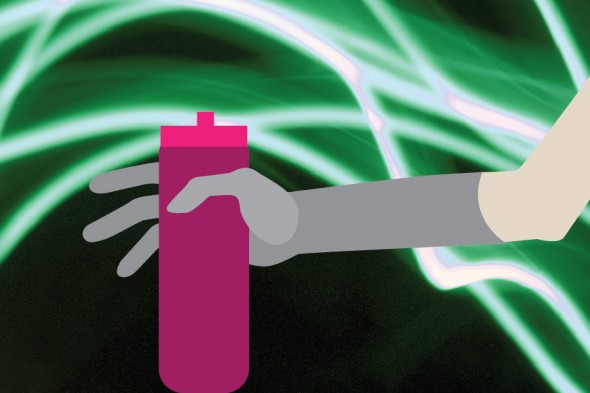‘Psychic robot’ senses user’s intention, corrects movements

UIC bioengineers are developing software that could guide a prosthetic arm to help a shaky patient smoothly lift an object. Illustration: Megan Strand
What if software could steer a car back on track when the driver swerves on ice? Or guide a prosthesis to help a shaky stroke patient smoothly lift a cup?
UIC bioengineers developed a mathematical algorithm that can “see” your intention as you perform an ordinary action like reaching for a cup or driving straight up a road — even if the action is interrupted.
“We call it a psychic robot. If you know how someone is moving and what the disturbance is, you can tell the underlying intent,” said Justin Horowitz, UIC graduate student research assistant and first author of the study.
“Say you’re reaching for a piece of paper and your hand is bumped mid-reach — your eyes take time to adjust; your nerves take time to process what has happened; your brain takes time to process what has happened and even more time to get a new signal to your hand.
“So, when something unexpected happens, the signal going to your hand can’t change for at least a 10th of a second — if it changes at all,” Horowitz said.
Processes information much faster than humans
In a first test of this concept, Horowitz employed exactly that scenario. He analyzed the movement of research subjects as they reached for an object on a virtual desk, but had their hand pushed in the wrong direction. He developed an advanced mathematical algorithm that analyzes the action and estimates the subject’s intent, even when there was a disturbance and no follow through.
“If we hit a patch of ice and the car starts swerving, we want the car to know where we meant to go,” he said. “It needs to correct the car’s course not to where I am now pointed, but where I meant to go.”
The car’s artificial intelligence would use the algorithm to bring the car’s course more in line with what the driver wanted to do, Horowitz explained.
“The computer has extra sensors and processes information so much faster than I can react,” Horowitz said. “If the car can tell where I mean to go, it can drive itself there. But it has to know which movements of the wheel represent my intention, and which are responses to an environment that’s already changed.”
For a stroke patient, a “smart” prosthesis could interpret what the person means to do even as the person’s own body corrupts the action by muscle spasms or tremors. The algorithm could make it possible for a device to discern the person’s intent and help complete the task smoothly.
The study is published online in the journal PLOS ONE. James Patton, professor of bioengineering, is principal investigator on the article. The study was performed at the Rehabilitation Institute of Chicago and supported by a grant from the National Institute of Neurological Disorders and Stroke.
